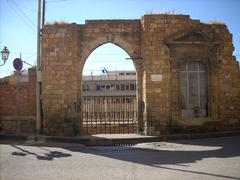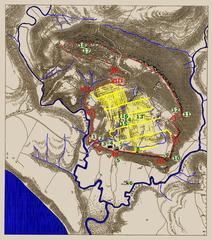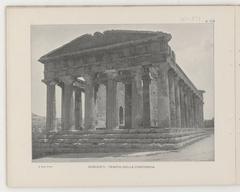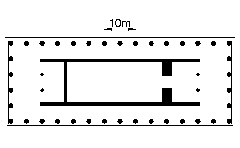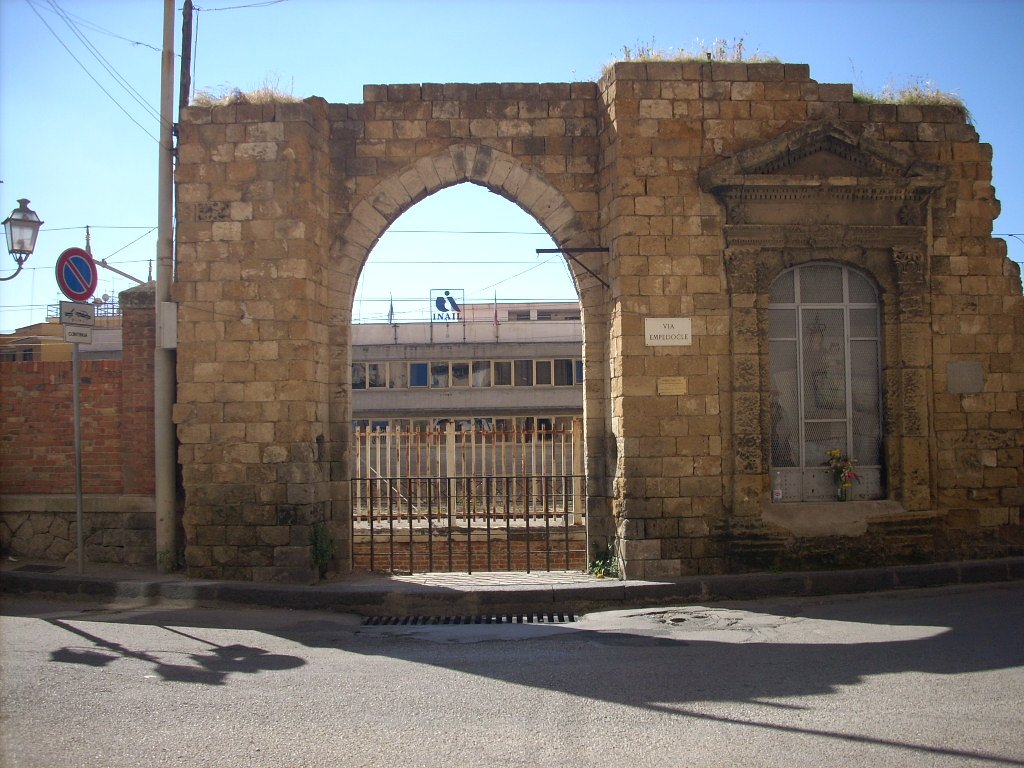
Porta Panitteri Visiting Hours, Tickets, and Agrigento Historical Sites Guide
Date: 14/06/2025
Introduction: Porta Panitteri and Its Significance in Agrigento
Porta Panitteri, set in the historical heart of Agrigento, Sicily, is a striking medieval gateway that invites visitors into the city’s rich, layered past. Dating back to the 9th century—a transformative era from Byzantine to Arab rule—Porta Panitteri embodies the complex cultural tapestry of Agrigento, once known as the ancient Greek colony of Akragas, founded in 581 BCE. As a strategic component of the city’s defensive walls, the gate features Gothic architectural elements, including its iconic pointed arch crafted from local limestone. Today, Porta Panitteri stands as a powerful symbol of Agrigento’s enduring urban and cultural heritage, connecting its medieval legacy with the city’s vibrant present (Ferrovie Siciliane; Travelling King).
Enhancing the historical landscape is the Panitteri Collection—an extraordinary set of ancient Greek Attic vases from the 6th and 5th centuries BCE. Assembled by Don Giuseppe Panitteri and housed for two centuries in Munich, the collection has returned to Agrigento for a landmark exhibition at the Museo Archeologico Regionale “Pietro Griffo.” This exhibition deepens the narrative of Agrigento’s cultural legacy and symbolically links the city’s classical and medieval heritage, especially significant during its tenure as Italy’s Capital of Culture 2025 (Storie & Archeostorie; Globalist).
This guide provides essential information for visiting Porta Panitteri, including practical details on hours, tickets, accessibility, and guided tours, while highlighting unmissable local sites like the Valley of the Temples, the Cathedral of San Gerlando, and the Monastery of Santo Spirito. Prepare for an immersive experience of Agrigento’s medieval gateway and its broader heritage landscape (Pro Loco Agrigento; Valle dei Templi).
Table of Contents
- Origins and Historical Context
- Architectural Features and Style
- Role in Urban and Social Life
- Cultural Significance and Symbolism
- Preservation and Modern Relevance
- Porta Panitteri and Agrigento’s Heritage
- Visiting Porta Panitteri: Hours, Tickets, and Accessibility
- The Panitteri Collection: Ancient Greek Ceramics in Agrigento
- Complete Guide: Location, Facilities, and Essential Tips
- Nearby Attractions, Dining, and FAQs
- Booking, Sustainability, and Further Information
Porta Panitteri: History, Architecture, and Urban Role
Origins and Historical Context
Porta Panitteri dates to the 9th century, a period marked by the transition from Byzantine to Arab rule in Sicily. As one of the rare surviving medieval fortifications in Agrigento (ancient Akragas), it illustrates the city’s evolution through centuries of conquest and cultural integration (Travelling King). Originally built as part of defensive walls protecting medieval Girgenti, the gate’s strategic location near Via Empedocle and the modern railway station underscores its historical role as a controlled entry point (Ferrovie Siciliane).
Architectural Features and Style
The gate is distinguished by its Gothic pointed arch, crafted from local limestone. Its structure reflects the layering of architectural styles over time, with influences ranging from Arab or Byzantine origins to later Norman and Gothic modifications (Ferrovie Siciliane). The modest yet evocative remains highlight the integration of ancient and modern elements within Agrigento’s cityscape.
Urban and Social Significance
Historically, city gates like Porta Panitteri regulated the flow of people and goods, serving as vital urban nodes. The gate’s proximity to key routes kept it central to the city’s economic and social life. Today, it marks a vibrant area where Agrigento’s past and present coexist (Ferrovie Siciliane).
Cultural Symbolism
Porta Panitteri is a tangible link to Agrigento’s past, symbolizing resilience through centuries of change. Its name may derive from a prominent family or from “panettiere” (baker), reflecting its historical role in the city’s daily life. The gate has been the subject of scholarly attention and local preservation efforts, illustrating its enduring importance (Travelling King; Archive.org).
Preservation and Modern Role
Despite its modest size, Porta Panitteri’s preservation is significant amid widespread loss of medieval fortifications elsewhere in Sicily. The juxtaposition of the ancient gate with the nearby railway and modern infrastructure offers a unique dialogue between past and present (Ferrovie Siciliane).
Visiting Porta Panitteri: Practical Information
Location and Access
Porta Panitteri sits in Agrigento’s historic center, within walking distance from Via Atenea and close to the Valle dei Templi archaeological park (Nomads Travel Guide). The site is easily reached on foot or via local shuttle services.
Visiting Hours
- Porta Panitteri: Open-air, accessible year-round; recommended visiting hours are 8:00 AM to sunset.
- Museo Archeologico Regionale “Pietro Griffo”: 8:30 AM to 8:00 PM (varies during special exhibitions; confirm on Valle dei Templi official website).
Tickets and Entrance Fees
- Porta Panitteri: Free admission; part of the public urban landscape.
- Guided Tours: Fees may apply; check with local operators.
- Museum & Archaeological Park: Standard entry €8–10; combined ticket €13–15; discounts for youth and seniors (Valle dei Templi).
Accessibility
- The museum and main park routes are wheelchair accessible.
- Porta Panitteri’s cobblestone paths and uneven surfaces may pose challenges for those with limited mobility—plan accordingly or join accessible tours (Voyage Tips).
Facilities
- Restrooms, cafés, and a gift shop are located near the museum and park entrances.
- Guided tours are available in multiple languages (The Tour Guy).
The Panitteri Collection: Ancient Greek Ceramics in Agrigento
Historical Background
Don Giuseppe Panitteri assembled an exceptional collection of 47 ancient Greek Attic vases (530–360 BCE) in the late 18th and early 19th centuries. Sold in 1824 to Ludwig I of Bavaria, these masterpieces resided at Munich’s Staatliche Antikensammlungen for nearly two centuries (Storie & Archeostorie; SiciliaTV).
Exhibition in Agrigento (2024–2025)
From December 18, 2024, to May 18, 2025 (extended to October 18, 2025), the Museo Archeologico Regionale “Pietro Griffo” hosts the exhibition, “Da Girgenti a Monaco. Da Monaco ad Agrigento. Il ritorno dei vasi del ciantro Panitteri.” This event marks their first return to Agrigento, celebrating the city’s role as Italy’s Capital of Culture 2025 (Globalist; Corriere del Simeto).
Exhibition Details
- Venue: Museo Archeologico Regionale “Pietro Griffo,” Parco Valle dei Templi
- Ticket: Included with standard museum entry
- Hours: 8:30 AM–8:00 PM (confirm on the official website)
- Accessibility: Fully accessible with ramps and elevators
- Languages: Exhibition panels in Italian, English, and German
Highlights
The exhibition presents ten outstanding vases featuring mythological, ceremonial, and everyday scenes, offering insights into ancient Greek artistry (Rete Chiara). Guided tours and an open-access digital catalog further enhance the experience.
Essential Visitor Tips
- Best Times: Spring and autumn for mild weather and fewer crowds (Audiala).
- What to Bring: Comfortable shoes, sun protection, water, and camera (note flash restrictions).
- Language: Italian and English are widely used; book multilingual tours in advance (Go Ask a Local).
- Safety: Respect barriers, keep noise low in museum spaces, and secure valuables.
Nearby Historical Sites
- Valley of the Temples: UNESCO World Heritage Site with celebrated Greek temples (Traveling Italian).
- Historic Center: Via Atenea, Cathedral of San Gerlando, Monastery of Santo Spirito (Eternal Arrival).
- Museo Archeologico Regionale “Pietro Griffo”: Home to the Panitteri vases and extensive ancient collections.
Dining and Refreshments
Enjoy Sicilian cuisine at local trattorias—try caponata, cavatelli alla norma, and almond desserts. Cafés and street vendors offer quick and authentic bites (Eternal Arrival).
Frequently Asked Questions (FAQ)
Q: What are Porta Panitteri’s visiting hours?
A: Accessible year-round, best visited during daylight hours (8:00 AM–sunset).
Q: Is there an entrance fee?
A: No, Porta Panitteri is free to visit. Museum and archaeological park require tickets.
Q: Are guided tours available?
A: Yes, multilingual tours can be booked in advance.
Q: Is Porta Panitteri wheelchair accessible?
A: The museum and park are accessible; old town streets may be challenging for wheelchair users.
Q: What is the best time to visit?
A: Spring and autumn, especially weekday mornings.
Booking and Further Information
- Book tickets and guided tours in advance, especially for the Panitteri Collection exhibition.
- Check the Valle dei Templi website and the Museo Archeologico Regionale “Pietro Griffo” for updates.
Sustainability and Responsible Tourism
Support local businesses, respect historic sites, and minimize waste. Participating in tours and cultural events helps preserve Agrigento’s heritage (Audiala).
Visuals and Interactive Elements
- Images: Include high-quality photos of Porta Panitteri and Panitteri vases with descriptive alt tags.
- Maps: Use interactive site maps for itinerary planning.
- Virtual Tours: Explore virtual experiences of Agrigento’s Old Town and Porta Panitteri.
Call to Action
For the latest updates on Porta Panitteri and Agrigento’s historical sites, download the Audiala app, follow us on social media, and explore related travel guides on our website. Plan your visit today and immerse yourself in the cultural richness of Agrigento!
Summary and Visitor Recommendations
Porta Panitteri is a testament to Agrigento’s historical depth, bridging ancient Greek origins with medieval and modern transformations. Alongside the Panitteri Collection exhibition, visitors can experience the full spectrum of the city’s heritage. Combine open-air exploration with guided tours, enjoy local cuisine, and visit renowned sites like the Valley of the Temples for a truly enriching journey. Engage with digital resources and cultural events to maximize your experience (Ferrovie Siciliane; Storie & Archeostorie; Valle dei Templi; Pro Loco Agrigento).
References
- Ferrovie Siciliane
- Travelling King
- Storie & Archeostorie
- SiciliaTV
- Globalist
- Corriere del Simeto
- Pro Loco Agrigento
- Valle dei Templi
- Nomads Travel Guide
- Voyage Tips
- Untold Morsels
- Yahoo Travel
- Traveling Italian
